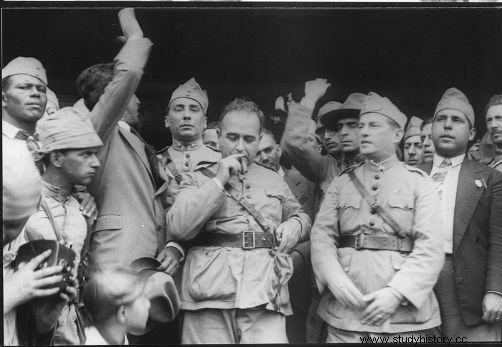
The Revolution of 1930 was one of the most important events of the Brazilian republican period, since it is consensually seen as the “watershed” between the “Republic Old ” and the centralizing power of the “Age Vargas ”, which began, precisely, with the success of the Revolution. To understand the importance of this event, we will see how the political atmosphere in Brazil was during the presidential elections of 1930 .
Liberal Alliance and the 1930 Elections
We know that the political agreements between the regional oligarchies that ruled the country at the time were one of the main characteristics of the “Old Republic”. The two main oligarchies were those of São Paulo and Minais Gerais, which sought to alternate in power in what became known as the “coffee with milk policy ”. However, in the presidential elections of 1930, the São Paulo oligarchy, which had the power in the situation, under the figure of the then president Washington Luis , did not continue the scheme of the conspiracies and launched another São Paulo candidate as Washington's successor, Júlio Prestes, contrary to the Minas Gerais oligarchy. This provoked the rupture of the miners against the paulistas.
Amid this situation, political leaders from other states took the opportunity to organize and dispute the same election against São Paulo, forming the so-called Alliance Liberal (AL ). The presidential candidate for AL was the gaucho Getúlio Vargas , then president of Rio Grande do Sul, and the candidate for vice was João Person , president of Paraíba.
Júlio Prestes had the direct help of Washington, the support of the powerful coffee growers of São Paulo, as well as the adhesion of seventeen presidents (at that time the governors were designated) of states, which controlled the electoral process through practices such as fraud, bribery, coercion, etc. Therefore, despite its great popularity, AL was resoundingly defeated at the polls, which were counted on May 21, with 1,091,709 votes in favor of Prestes against 742,794 obtained by Vargas.
João Pessoa assassination and the revolutionary outbreak
The defeat at the polls did not end the climate of political instability. Part of the Minas Gerais oligarchs, already broken with those from São Paulo, ended up associating themselves with the leaders of the Liberal Alliance. The latter, in turn, dissatisfied with the blatant manipulation of the elections, also began to articulate with the low-ranking young military men, remnants of the revolts lieutenants , like Juarez Távora . The civil-military coalition that would overthrow the Old Republic was armed. The “trigger” was missing for the revolution to erupt and obtain popular support. This trigger occurred in Paraíba.
On July 26, 1930, João Pessoa, who had been Getúlio's vice-president, was murdered by one of his fellow countrymen, João Duarte Dantas . Dantas claimed that his office had been invaded by people linked to João Pessoa and that intimate letters had been taken and published. In this way, an incident of a more personal than political nature ended up serving as a detonator for the revolution. Pessoa's death was widely claimed by Vargas and the AL as proof that it was necessary to end the political system in force until then. It was then that the properly military actions against the Washington Luiz government began.
As historians Lilia Schwarcz and Heloísa Starling point out:
In just over a week, the rebels dominated the military situation in Rio Grande do Sul. With the loyalist forces neutralized, Góes Monteiro moved his troops, by rail, in the direction of São Paulo. The chances of success were real, and this time, Getúlio Vargas played his luck in winning the Liberal Alliance – wearing a khaki denim uniform, he assumed civilian command of the rebellion and went ahead with the military convoy. In Itararé, on the border between Paraná and São Paulo, the biggest and most effective combat between the rebels and the loyalist forces was foreseen. The city, in the interior of São Paulo, housed a decisive railway junction for the two sides in conflict:the rails opened the way to both São Paulo and Rio de Janeiro. [1]
Vargas takes over
On October 24, 1930, the Revolution reached its high point, with the deposition of Washington Luís. However, it was clear that, in the midst of an atmosphere still of political tension, with the oligarchic structure still standing, a new electoral process could not be held immediately. Vargas, then, with military support, started a provisional government, which only ended four years later. As the aforementioned historians say:
Vargas did not intend to jeopardize his own achievement. It was clear that if he held elections, the regional elites, whose structures of command at the state level remained intact, would win. To institutionalize the new order, it would be necessary to transform the political system and consolidate a broad program of social, administrative and political reforms. The project was ambitious, it could not be carried out overnight, but even Távora himself could not foresee that the dictatorship he defended, in 1930, would last for fifteen long years, with a brief constitutional interregnum from 1934 to 1937. [2]
NOTES
[1] Schawrcz, Lilia M. and Starling, Heloisa M. Brazil:A Biography. São Paulo:Companhia das Letras, 2015. p. 360.
[2] Ibid . P. 362.
Take the opportunity to check out our video lesson on the subject:
